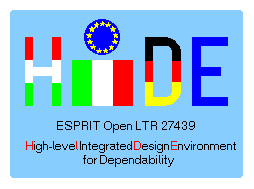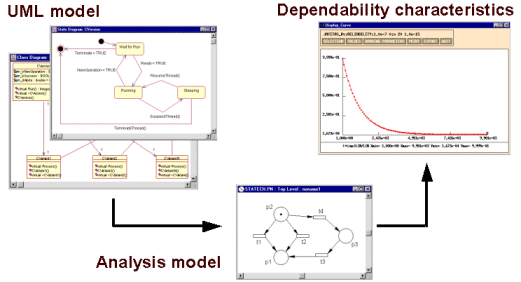High-level integrated design environment for dependability
(HIDE)

ESPRIT Open LTR 27439Period:
1998Participants:
Department of Computer Structures, University of Erlangen, GermanyProject aim:
Pisa Dependable Computing Centre, Italy
Department of Measurement and Information Systems, Budapest University of Technology and Economics, Hungary
Intecs Sistemi SpA, Italy
MID GmbH, Germany
The main objective of HIDE is the creation of an integrated environment for the practitioner designer, allowing him to use UML as front-end for the specification of both the system and the user requirements. The user can validate his design in an easy-to use form, since the background mathematics will be hidden from him. Automatic transformations will derive the individual mathematical models for formal and quantitative validation from the basic UML model, and the results gained without the interaction of the user will be back-annotated for presentation into the same UML model, as well. This way HIDE eliminates the need for both a specific expertise in abstract mathematics, and the tedious manual re-modelling of the system.Further information:
HIDE aims at the extension of modern system design methodologies, like CASE and HW-SW co-design, by mathematical model based analysis and validation. UML, as the most recently created industry standard of system modelling, covers the entire functional design process and offers a flexible modelling paradigm. It comprises a variety of formalisms for a comfortable formulation of the solution, efficient visualization adapted to the engineer’s way of thinking, hierarchical model refinement, the exploitation of parallelism and referential transparency, and design re-use.
The major objective of this project phase was the creation of an experimental platform for the validation of all major conceptual aspects based on commercial UML toolsets, as InnovatorTM from MID, in a slightly customized form. The experimental HIDE framework incorporated:
- A completely UML-compliant specification of the extensions of the system modelling methodology needed for performance and dependability modelling.
- The methodology for model transformations in the form of scripts.
- Study of transformations of (enriched) UML models into stochastic models and paradigms for which model resolution and quantitative evaluation is fully supported by efficient tools.
- Study of transformations of UML descriptions of behaviors and related properties into concurrency semantic models and paradigms for which automatic verification is supported.
Prototype implementations of selected transformations were provided and their benchmark based evaluation were performed.
Project leaflet (in Adobe Acrobat PDF format)
András Pataricza, Ph.D.

